It’s a good day to talk about the science topic about famous scientist plus their contributions to the atom theory. In every era many scientist born into existence, start from the Ancient world until the modern era. They are always have the same traits, they had fought in justice to revealed the mystery of universe. These scientist had revealed how the atom theory had influenced our universe.
Here is the list of scientist plus their innovation in chemistry especially atom theory. You may see many unfamiliar names you can’t find in other website such as Rhazes, Homi Jehangir Bhabha and Hideki Yukawa. They are great scientist from Persia, India and Japan. This article will give you many information about scientist who contributed to the atom theory may increase your insight.
You may also read:
- Branches of Chemistry
- Branches of Analytical Chemistry
- Branches of Physical Chemistry
- Branches of Inorganic Chemistry
1. Democritus
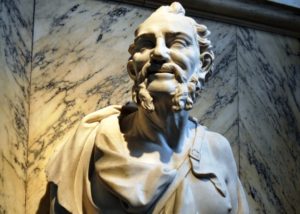 Democritus was the world’s first great atomic philosopher. He was Born in Thrace, Greece around 460 B.C. Democritus was studied under Leucippus in Abdera, and spent his inheritance in research abroad. He began traveled in Egypt for 5 years and the continued his journey to Chaldea, Babylon, Persia, and India.
Democritus was the world’s first great atomic philosopher. He was Born in Thrace, Greece around 460 B.C. Democritus was studied under Leucippus in Abdera, and spent his inheritance in research abroad. He began traveled in Egypt for 5 years and the continued his journey to Chaldea, Babylon, Persia, and India.
Democritus was interested in all branches of philosophy, mathematics, astronomy, and medicine. He wrote many books, but they are not known to us. He was a cheerful philosopher and lived to the age of 80. Meanwhile, his theories now is used as the basic knowledge in many basic fields.
Democritus’s Contribution to The Atom Theory
Democritus was said the world was made of only two things: “The vacuum of empty space and the fullness of matter.” All matter consisted of particles, so small that nothing smaller could be imagined. These particles were indivisible, the word atom itself mans “that which cannot be cut.” These atoms were eternal, unchangeable, and indestructible. Beside this great theory, his idea were based strictly on deductive reasoning, not on experimenting and testing.
2. Rhazes
 He is also known as Abu Bakr Muhammad bin Zakariyya, he was born on 854 – 930, in Rayy near the city of Teheran, in Abbasyid Calliphate era (now Iran). He was a Persian. Meanwhile, Rhazes is famous as a polymath, because he is a physician, a philosopher, and an alchemist.
He is also known as Abu Bakr Muhammad bin Zakariyya, he was born on 854 – 930, in Rayy near the city of Teheran, in Abbasyid Calliphate era (now Iran). He was a Persian. Meanwhile, Rhazes is famous as a polymath, because he is a physician, a philosopher, and an alchemist.
In Rayy, in his homeland, he was well trained in the Greek Sciences. He love in musical theory field and he learned the musical performance in his youth. In middle age, he works in chemistry field and he invented many contributions to chemistry.
But in his later life, there was an accident that almost made him eyes blind. Because of this accident, he decided not to work in chemistry field anymore, he switch to another medicine field. He was founded the first hospital in Rayy, Iran. This hospital later became his most valuable legacy in medieval Islamic golden age .Today many scientist argued he was The Creator of Modern Science, because many his contribution that influenced the chemistry world.
Rhazes’s Contribution in Atom Theory
Rhazes wrote many literature about nature of matter, his expose of the risks of ignoring the axioms of geometry, may aim at kalam defenders of dimensional atoms. It became the famous theory known as The Physical Theory of Kalam. This theory has a unique history, when Rhazes tried for searched about the soul where he thought the atom is the smallest unit in our soul.
At the beginning of development Theory of Kalam, he wanted contribute for philosophy science, but later he knew this theory could influenced in chemistry area, especially in Atomic Theory subject. Rhazes had analyzed the concept of atoms as a ‘space-occupying object’ without dimension yet having magnitude. It examines the manner of the atom‘s occupation of space, and discusses arguments for and against unoccupied spaces of the void.
His Kalam Theory was influenced by Pythagoreanism about square side with it’s diagonal effect to atom and his view also influenced by Aristotle theory The Four Elements which made change to atom movement in the space. Today, he became known for his contribution about his systematize chemistry laboratory practice where this method is common used in today chemistry experiment.
3. Robert Boyle
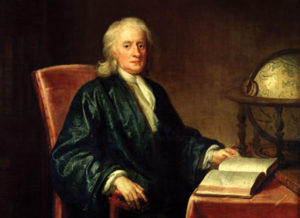 Robert Boyle was born on January 25, 1627, Ireland. He was a British natural philosopher, particularly in the field of chemistry. In 1654, he was invited to Oxford, and he took up residence at the university from 1656 until 1668. His mother died when he was three years old, so his very loving father raised him. In 1654, he settled in Oxford, where he did much of his work with Robert Hooke.
Robert Boyle was born on January 25, 1627, Ireland. He was a British natural philosopher, particularly in the field of chemistry. In 1654, he was invited to Oxford, and he took up residence at the university from 1656 until 1668. His mother died when he was three years old, so his very loving father raised him. In 1654, he settled in Oxford, where he did much of his work with Robert Hooke.
He wrote in his book, The Philosophical Works of the Honourable Robert Boyle, about the many conflicting remedies and various diagnoses of the physicians of his time. He classified substances as acids, bases, or salts. Boyle was the pioneer in collect and isolate a gas. He argued the vaccum could not exist by many opinion by 17th centuries scientist.
Boyle’s contribution to Atom Theory
His contribution to chemistry, especially in Atomic Science, he was thought which were a mechanical “corpuscular hypothesis. This a brand of atomism which claimed that everything was composed of minute but not indivisible particles, of a single universal matter and that these particles were only differential by their shape and motion. His most famous contribution was the definition of an element which the element could be made from 2 or more substance which is not an element.
4. John Dalton
 John Dalton was born on September 5, 1766 in England. Dalton’s father owned a house and a small land which made Dalton easier for took his education in his childhood. From his childhood he was a smart person, because he had interested about his surroundings and he always tried for learning this as much as he could. When he became adult, he explored in Meteorological Field. He had been a meteorologist and later he became a chemist.
John Dalton was born on September 5, 1766 in England. Dalton’s father owned a house and a small land which made Dalton easier for took his education in his childhood. From his childhood he was a smart person, because he had interested about his surroundings and he always tried for learning this as much as he could. When he became adult, he explored in Meteorological Field. He had been a meteorologist and later he became a chemist.
John Dalton was famous because he was a pioneer in the development of modern atomic theory. Dalton had published a famous essays with the title Meteorological Observations and Essays. Today, Dalton become famous because he is the first pioneer in modern atomic theory. Many people consider him as the Creator of Modern Atom Science.
Dalton’s Contribution to Atom Theory
Dalton’s most influential work in chemistry was his atomic theory. The theoretical foundation of Dalton’s atom theory was mainly based on the law of conservation of mass and the law of definite proportional), both of which had already been established, and the law of He based his theory of partial pressures on the idea that only like atoms in a mixture of gases repel one another, whereas unlike atoms appear to react indifferently toward each other. multiple proportions) which was developed by Dalton himself.
The atom of Democritus may be said to be as a kind of miniature of matter. Dalton uses the term ‘particle’ for what we now call a ‘molecule’, the smallest part of a substance. He uses the word ‘atom’ to refer to the tiniest part of a simple body or an element. Hence the number of the type of atoms is equal to that of the type of matter. On the other hand, Dalton’s atom is a constituent of matter, and many compounds are formed by the combination of a limited number of atoms.
Dalton uses the term ‘particle’ for what we now call a ‘molecule’, the smallest part of a substance. He uses the word ‘atom’ to refer to the tiniest part of a simple body or an element. Hence the number of the type of atoms is equal to that of the type of matter. On the other hand, Dalton’s atom is a constituent of matter, and many compounds are formed by the combination of a limited number of atoms.
5. Amedeo Avogadro
 Avogadro was born on August 9, 1776, Italy. An Italian mathematical physicist. At first he followed the family route by taking studies in law and theology. He was attended the campus l’Avvocatura dei Poveri in 1896, then l’Avvocatura Generale.
Avogadro was born on August 9, 1776, Italy. An Italian mathematical physicist. At first he followed the family route by taking studies in law and theology. He was attended the campus l’Avvocatura dei Poveri in 1896, then l’Avvocatura Generale.
Avogadro became Secrétaire du Département d’Eridanus in 1801. At this time, he was started interest in natural sciences and mathematics and he pursued it. Then, he entered a university course in physics. In 1804, aged 28, he sent two essays on electricity to the Academy of Sciences of Turin, of which he became a corresponding member.
Avogadro’s Contribution to Atom Theory
The first, known as Avogadro’s hypothesis, lead to the present notion of the mole, and is characterized by the Avogadro number (N). The second allowed for a distinction to be made between O and O2, namely, the atom and its molecule, and is the basis for the notion of a molecule.
Many Avogadro’s ideas and methods anticipated later development in physical chemistry. His hypothesis is now regarded as a law, and the value known as Avogadro’s number (6.02214179 x 1023), the number of molecules in a gram molecule, or model, of any substance, has become a fundamental constant of physical science. This atom theory became a common knowledge for chemistry students today.
Also read: Proton, Electron, Neutron
6. Dmitry Ivanovich Mendeleev
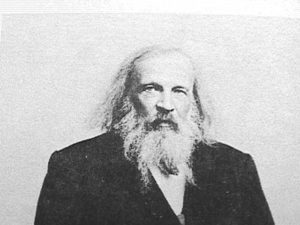 Mendeleev was born on January 27 1834, Russian Empire (now is Russia). His grandfather was Pavel Maximovich Sokolov, a priest of the Russian Orthodox Church. His father was a teacher of fine arts, politics and philosophy.
Mendeleev was born on January 27 1834, Russian Empire (now is Russia). His grandfather was Pavel Maximovich Sokolov, a priest of the Russian Orthodox Church. His father was a teacher of fine arts, politics and philosophy.
Mendeleev was raised as an Orthodox Christian. In 1850, Mendeleev was entered to Saint Petersburg University and after graduation he moved to the Crimean Peninsula in the northern coast of the Black Sea in 1855. He had won the Demidov Prize of the Petersburg Academy of Sciences. By his textbook,”Organic Chemistry.”
Mendeleev’s Contribution to Atom Theory
After studying the alkaline earths, Mendeleev established that the order of atomic weights could be used not only to arrange the elements within each group but also to arrange the group themselves. His effort was discovered the periodic law. This periodic law known as periodic table. The table had great contribution for chemical, particularly in Atomic theory.
Mendeleev became famous of his table and periodic law. Now many students use his table to learn Chemist. Mendelev also created the atomic data which made him discovered what is called the Periodic Law. In purpose for increasing atomic mass, he was arranged the elements. From his atom experiment, he discovered the properties was repeated. On his table, periodically the properties were repeated. Because of this, this system is known as periodic table.
In periodic table there are many elements group by atomic mass order. In order of increasing “Atomic Number”, he had placed the elements in the table. The number shows how many positive charge protons in the atom? Not only positive charge proton, it’s also represent the amount of negative charge electron. Mendeleev became famous of his table and periodic law. Now many students use his table to learn Chemist.
7. Max Karl Ernst Ludwig Plack
 Planck was born on April 23, 1858, in Germany. He was the son of Julius Wilhelm and Emma Planck. His father was Professor of Constitutional Law in the University of Kiel, and later in Gottingen. Planck had received his doctorate of philosophy at Munich in 1879. From 1880 to 1885 he was a Privatdozent in Munich, then he became Associate Professor of Theoretical Physics at Kiel until 1889. In this year, he succeeded Kirchhoff, the famous scientist, as Professor at Berlin University.
Planck was born on April 23, 1858, in Germany. He was the son of Julius Wilhelm and Emma Planck. His father was Professor of Constitutional Law in the University of Kiel, and later in Gottingen. Planck had received his doctorate of philosophy at Munich in 1879. From 1880 to 1885 he was a Privatdozent in Munich, then he became Associate Professor of Theoretical Physics at Kiel until 1889. In this year, he succeeded Kirchhoff, the famous scientist, as Professor at Berlin University.
Planck’s Contribution to Atom Theory
Planck was introduced the quantum theory in 1900, stating that electromagnetic energy could only be permitted in quantized form. This theory could not explain the energy carried by the sun rays. Unless there is a particle the heat cannot be carried. His quanta are now called photons by physicist. Later in 1918, he originated quantum theory made he won the Nobel Prize for Physics.
8. Albert Einstein
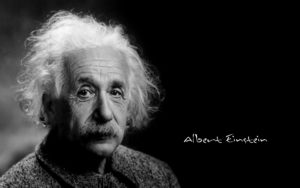 Einstein was born on March 14, 1879, Germany. He began his schooling at the Luitpold Gymnasium. And then, his family moved to Italy and Albert continued his education at Aarau, Switzerland. He attended Luitpold Gymnastic Highschool in 1888. To 1896, an then he took his secondary education to the cantonal school of Aarau, Switzerland.
Einstein was born on March 14, 1879, Germany. He began his schooling at the Luitpold Gymnasium. And then, his family moved to Italy and Albert continued his education at Aarau, Switzerland. He attended Luitpold Gymnastic Highschool in 1888. To 1896, an then he took his secondary education to the cantonal school of Aarau, Switzerland.
Einsteinentered the Swiss Federal Polythecnic of Zurich in 1896. He enrolled to this college by the letter from his mathematician teacher, the more fascinating is he could entered this college two years before he officially eligible to take the entrance examination. The more amazing facts is Einstein had mastered the entered mathematics curriculum at his school.
After education in Germany, Italy, and Switzerland, and professorships in Bern, Zurich, and Prague, he was appointed Director of Kaiser Wilhelm Institute for Physics in Berlin in 1914. He became a professor in the School of Mathematics at the Institute for Advanced Study in Princeton beginning the fall of 1933, became an American citizen in the summer of 1936.
At second world war Einstein was became Nazi’s party fugitive because he is Jewish. Even Hitler had put the bounty with million dollar! But this story was not long, because Hitler had attemped suicide on 30th April 1945. There was a funny thing, after the atom bomb had released in Japan, Einstein was took his holiday in Japan! From his tour, Einstein had an idea for controlling the atom bomb under an organization. Soon after that, the president USA was established The Organization for Controlling Atomic Bomb. Einstein was supported the organization for world good.
After the second world war, Einstein had enjoyed his free time. He also campaigned Anti Zionisme in the USA. When the Israel President will visit to USA, Einstein had wrote in article of New York Time to inciting USA people for rejecting the president to arrive in USA. This event had occured the unrest between Jews people around the world where many Jews people support his article and criticized the Israel Zionism, because the Zionism had harrased the Palestinian people. Overall Einstein was a pacifist, because he supported for The Atom Controlling Organization Establishment and he support Palestine country.
After his funeral in Princeton, New Jersey on April 18, 1955, the doctor of the hospital where his body were burried, began the operation for took his brain in aim of his brain research.
Einstein became most popular scientist today, especially in Physics and Atom Science.
Einstein’s Contribution to Atom Theory
Einstein had the vision that made him obsessed since he was 16 : “What will happen if you race alongside a light beam?” He studied Maxwell’s equations, which describe the nature of light, and discovered that the speed of light remained the same no matter how fast one moved. This insight led Einstein to formulate the principle of relativity : “The speed of light is a constant in any inertial frame or constantly moving frame.”
In November 1915, Einstein finally completed the general theory relativity known as “E = mc^2”, which he considered to be his masterpiece. During the late 1930’s, many physicist began consider to Einstein’s equation “E = mc^2.” Might make an atomic bomb possible. In 1938-1939, a group of physicist showed that vast amounts of energy could be unleashed by the splitting of the uranium atom.
9. Hideki Yukawa
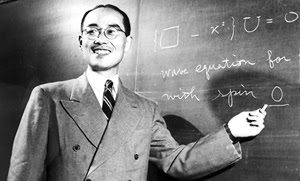 Hideki Yukawa was born on January 23, 1907 in Japan. His father was Takuji Ogawa, a Professor of Geology in Kyoto University. He was completed his degree program from Kyoto University, Japan, and later won several honors and affiliations from numerous universities abroad, such as the Columbia University and New York University. He obtained his D.Sc from Osaka University in 1938. Hideki became a lecturer at the University of Kyoto since 1932 to 1938, in 1939 he was became a Professor of theoretical physics at the University. He dedicated his life to research in the field of Quantum Mechanics in Physics.
Hideki Yukawa was born on January 23, 1907 in Japan. His father was Takuji Ogawa, a Professor of Geology in Kyoto University. He was completed his degree program from Kyoto University, Japan, and later won several honors and affiliations from numerous universities abroad, such as the Columbia University and New York University. He obtained his D.Sc from Osaka University in 1938. Hideki became a lecturer at the University of Kyoto since 1932 to 1938, in 1939 he was became a Professor of theoretical physics at the University. He dedicated his life to research in the field of Quantum Mechanics in Physics.
Hideki’s Contribution to Atom Theory
When Hideki was 27 year old, he produced works entitled “On the Interaction of elementary Particles I.” It introduced a new theory of the nuclear force and predicted the existence of particles called Mesons. He proposed a new theory of nuclear forces including the existence of the meson in 1935, theorizing that the meson acts as a glue, holding various other particles together to form the nucleus of the atom. Many scientist called it “meson”, because the particles are among the masses of the electron and the proton mass, ranging from 200-300 times the mass of the electrons. The discovery of particle meson made Hideki Yukawa popular. It also made Hideki was confirmed as a Nobel Laureate in Physics. He became the first Japanese to be awarded the Nobel prize.
10. Homi Jehangir Bhabha
 Homi Jehangir Babha was born on 30 October 1909 in Mumbai, India. In Mumbai, he attended the Cathedral & John Connon School and then Elphinstone College, followed by the Royal Institute of Science. He earned his engineering degree in 1930 and Ph.D. in 1934.
Homi Jehangir Babha was born on 30 October 1909 in Mumbai, India. In Mumbai, he attended the Cathedral & John Connon School and then Elphinstone College, followed by the Royal Institute of Science. He earned his engineering degree in 1930 and Ph.D. in 1934.
He wrote his doctorate nuclear physics The Absorption of Cosmic Radiation about absorption features and electron shower production in cosmic rays, made him win the Issac Newton Studentship in 1934. Bhabha established the Tata Institute of Fundemental Research(TIFR) for carrying out nuclear science research in 1945. This made him as “The Father of India’s Nuclear Program”.
Bhabha’s Contribution in Atom Theory:
In 1937, together with W.Heitler, a German physicist, Bhabha solved the riddle about cosmic rays. Cosmic rays are fast moving, extremely small particles coming from outer space. When these particles eter the earth’s atmosphere, they collide with the atoms of air and create a shower of electrons. Bhabha’s discovery of the presence of nuclear particles (which he called messons) in these showers was used to validate Einstein’s theory of relativity making him world famous.
Meanwhile, there are many scientist who contributed to the atomic theory such as Einstein, Boyle, and more. Their theories now is used in many applications of life, mostly, for chemistry studies. Indeed, we may look better on their movements, researches, and knowledge.
Also read:
